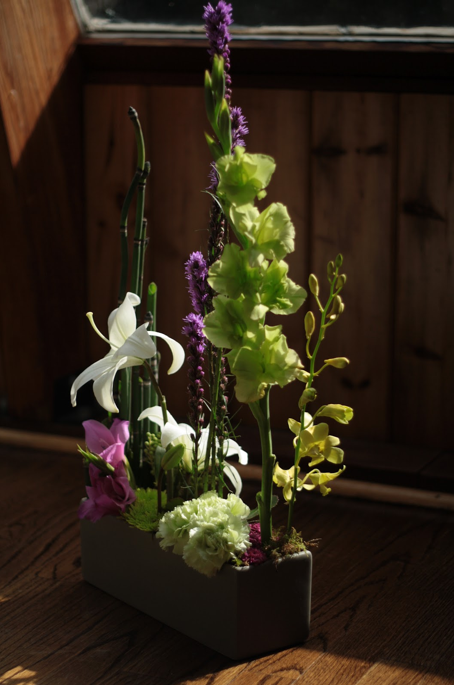A nasty stomach bug prevented me from attending a day of classes, so I attempted to do the first design we learned this day at home, following directions from the book The Art of Floral Design by Norah Hunter (with Jane’s blessing, of course.) My teacher was very understanding about me missing the class, and I’ll be able to attend at least the lecture portions during the class held this fall.
Here’s what I’m making: the New Convention design, which is a structured, linear-style design. It’s like the parallel design on steroids – with the addition of horizontal materials. Vertical lines are reflected at sharp right angles forward, backward and to the side using identical materials. Contrasting textures are used at the design’s base where all the lines converge. The book gives you a pretty good how-to diagram.
To begin, select a low rectangular container. Cut floral foam to extend above the rim of the container (to allow the horizontal placement of materials) and secure with tape. Plan your design by placing stakes in areas where flowers will be grouped. I wanted my end geometric form to be triangular, with the top point in the center.
What’s really exciting is that I bought a cake decorating spinny thing which makes floral design so much easier.! (Purchased on Amazon for $18) Maybe that’s only exciting to me. Anyway – next, add your vertical materials. I chose snapdragons, agapanthus, and tulips which I bound together with a little wire. I thought it might be neat to see how the tulips keep growing while confined in a bunch.
Part of this assignment was learning to unite materials, something our class handout talked about. But the book didn’t really mention these techniques as part of the New Convention design, so I didn’t go overboard on it. However, I think I probably should have done a little more of the following:
Banding: Tying materials for purely decorative purposes.
Binding: Tying materials for functional purposes, physically joining the materials together.
Bundling: Tying or wrapping similar materials together into one unit, such as sheaves of wheat or a bundle of sticks. The bundle may then be placed in the floral design.
Wrapping: A technique in which fabric, ribbon, raffia, cord or wire are used to cover, coil, or twine a single stem or group of stems to achieve a decorative look.
Next, insert stems into sides of foam at right angles to the vertical groups. Horizontal lines are shorter than vertical groups. I used the exact same material to reflect the vertical groupings. Then, complete the base of the design with short flower heads, mosses and leaves using basing techniques (remember pave, clustering, tufting, terracing, etc from the parallel design?) I went totally crazy here, but I wanted it to look full and I had tons of material to work with. I wasn’t sure about ‘point of emergence’ for this one, so I just did my best. I think my foam was too high and we have a lot of competing elements here because I needed to fill up the space…

from a carpet of gerber daisies springs white ornithogalum, eryngium, and some euphorbia x martinii 'ascot rainbow' (euphorbia from my cutting garden, yew foliage from parent's yard)
Our handout talked about dominance – which is the greater effect of an element – it must be clear in a design and imply subordination.
Linear Dominance – a certain type of lines take the role of importance by either quantity or size (for my design, I think the agapanthus wins because of size and rhythm of lines)
Color Dominance – one hue or strong colors (the purple of the agapanthus draws your eye, but the orange gerber daisy is a dominant focal point I think)
Form Dominance – clearly developed
Textural Dominance – one type of texture (my design has lots of textures and I don’t think one dominates – do you?)
Space dominance – either very full or very open space (it’s pretty full eh?)
And as far as the focal area goes – the dominant place within a design which has the strongest visual impact – I think there are multiple focal areas in this one.
An accent is a subordinate element that contrasts or complements the dominant element – the accent is often connected to the focal area of a design. Here, the ivy is the accent to the roses.
I sent some pics to my teacher Jane and I’m waiting to hear back on whether I’m anywhere in the ballpark here. (Maybe she’ll comment right here on my blog! Wouldn’t that be something?) I welcome any comments and criticism on this design – advanced Longwood students, I would really like to know what you thought of this assignment.
Stay tuned for more adventures in floral design!
ADDENDUM: I talked to Jane over the phone and she gave me a thumbs up on my design. We got to talking about all the foam used for this particular bad boy, and she’s thinking the New Convention won’t be taught in next year’s Advanced I class in order to conserve the use of Oasis to a minimum. I really enjoyed making this design, but I can see how 24 students x 2 blocks of foam starts to add up!






















